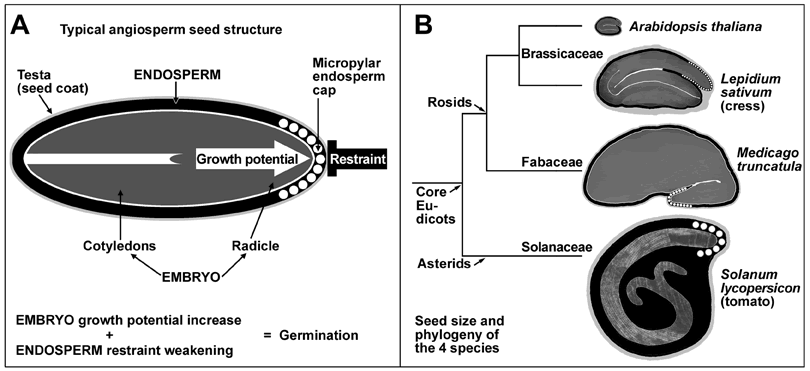Book chapter 4 - Topics in Current Genetics 21: 43-67 (2010)
Dormancy in plant seeds
Wageningen University, Lab of Plant Physiology, Droevendaalsteeg 1, 6708 PB, Wageningen, The Netherlands (H.W.M.H.)
School of Life Sciences, Warwick University, Wellesbourne, Warwick CV35 9EF, UK (W.E.F.-S.)
UMR 1191 Molecular Seed Physiology, INRA, 16 Bd Lavoisier, 49045, Angers, France (J.B., W.B.)
University of Freiburg, Faculty of Biology, Institute for Biology II, Botany / Plant Physiology, Schänzlestr. 1, D-79104 Freiburg, Germany, Web: 'The Seed Biology Place' http://www.seedbiology.de (G.L.-M.)
Book editors: Esther Lubzens, Joan Cerda, Melody Clark
DOI 10.1007/978-3-642-12422-8_4
Book based on oral presentations of the
Wworkshop "Sleeping Beauties - Dormancy and resistance in harsh environments: Molecular, proteomic and metabolomic aspects", May 2008, MPI Dahlem-Berlin, Germany.
Abstract
Seed dormancy has been studied intensely over the past decades and, at present, knowledge of this plant trait is at the forefront of plant biology. The main model species is Arabidopsis thaliana, an annual weed, possessing nondeep physiological dormancy. This overview presents the state-of-the-art of seed dormancy research, focusing mainly on physiological and molecular-genetic aspects in this species. It has become clear that, like in many other organisms, the dormancy and stress responses are tightly associated in seeds. The plant hormones, abscisic acid and gibberellins, play a pivotal role in the acquisition of developmental arrest or repression of metabolic inactivity, respectively. Some attention is given to the overlapping dormancy and stress responses, commonly studied in many other organisms but only marginally in seeds.

Figure 4.1: Seed structures, sizes and phylogenetic relationships of model and crop species.
(a) Generalised structure of an angiosperm (eudicot) seed with EMBRYO and ENDOSPERM as the two important seed components. The direction of embryo growth (arrow ‘Growth potential’) that results in germination (rupture of the endosperm) and repressive function of endosperm (block ‘restrain’) are shown.
(b) Phylogenetic relationship and seed size comparison for Arabidopsis, Lepidium, Medicago, and tomato. The four species represent important model and crop plants.
| Article in PDF format (573 KB) |
|
|
The Seed Biology Place |
Webdesign Gerhard Leubner 2000 |